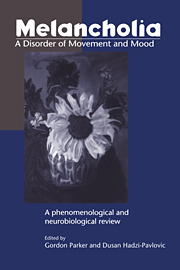Book contents
- Frontmatter
- Contents
- List of contributors
- Acknowledgments
- Introduction
- Part One Classification and Research: Historical and Theoretical Aspects
- Part Two Development and Validation of a Measure of Psychomotor Retardation as a Marker of Melancholia
- 5 Psychomotor Change as a Feature of Depressive Disorders: Historical Overview and Current Assessment Strategies
- 6 Development and Structure of the CORE System
- 7 Reliability of the CORE Measure
- 8 Validity of the CORE: I. A Neuroendocrinological Strategy
- 9 Validity of the CORE: II. Neuropsychological Tests
- 10 Validity of the CORE: III. Outcome and Treatment Prediction
- 11 Phenotypic Expression of Melancholia Contrasted for Those with Bipolar and Unipolar Illness Courses
- 12 Psychotic Depression: Clinical Definition, Status and the Relevance of Psychomotor Disturbance to Its Definition
- 13 A Clinical Algorithm for Defining Melancholia: Comparison with Other Sub-typing Measures
- 14 Rating the CORE: A User's Guide
- Part Three The Neurobiology of Melancholia
- The CORE Measure: Procedural Recommendations and Rating Guidelines
- References
- Author Index
- Subject Index
5 - Psychomotor Change as a Feature of Depressive Disorders: Historical Overview and Current Assessment Strategies
from Part Two - Development and Validation of a Measure of Psychomotor Retardation as a Marker of Melancholia
Published online by Cambridge University Press: 04 August 2010
- Frontmatter
- Contents
- List of contributors
- Acknowledgments
- Introduction
- Part One Classification and Research: Historical and Theoretical Aspects
- Part Two Development and Validation of a Measure of Psychomotor Retardation as a Marker of Melancholia
- 5 Psychomotor Change as a Feature of Depressive Disorders: Historical Overview and Current Assessment Strategies
- 6 Development and Structure of the CORE System
- 7 Reliability of the CORE Measure
- 8 Validity of the CORE: I. A Neuroendocrinological Strategy
- 9 Validity of the CORE: II. Neuropsychological Tests
- 10 Validity of the CORE: III. Outcome and Treatment Prediction
- 11 Phenotypic Expression of Melancholia Contrasted for Those with Bipolar and Unipolar Illness Courses
- 12 Psychotic Depression: Clinical Definition, Status and the Relevance of Psychomotor Disturbance to Its Definition
- 13 A Clinical Algorithm for Defining Melancholia: Comparison with Other Sub-typing Measures
- 14 Rating the CORE: A User's Guide
- Part Three The Neurobiology of Melancholia
- The CORE Measure: Procedural Recommendations and Rating Guidelines
- References
- Author Index
- Subject Index
Summary
Irrationality and overt behavioural disturbance have been since Greek times the two central features of madness.
(Berrios 1985)All writers agree as to the importance of it, but few define it or its manifestations, leaving such phrases as “psychomotor retardation” or “inhibition” to speak for themselves.
(Lewis 1934)Historical Overview
In this book we argue that psychomotor disturbance (PMD) is both a key defining characteristic of melancholic depression and a reflection of its underlying pathophysiology. As noted by Rush and Weissenburger (1994), the terms “endogenous” and “melancholic” have had differing meanings, including particular patterns of clinical features. In their overview of nine “diagnostic operationalizations” of the melancholic concept, psychomotor retardation was the only feature to be included in all nine systems, while psychomotor agitation was included in six. Nevertheless, psychomotor disturbance is principally viewed as either (a) merely one of several features weighted to such a diagnosis; or (b) more related to depression severity than to depression sub-typing and, as such, to be secondary to the primary mood disturbance. We will argue that PMD's utility as a specific defining feature of melancholia is dependent on its measurement (requiring some precision in defining its underlying domains and appropriate descriptors; and using behavioural ratings rather than relying on symptom self-report data), and that such measurement difficulties have resulted in lack of appreciation of its possible “necessary and sufficient” status as a melancholic sub-typing feature.
Information
- Type
- Chapter
- Information
- Melancholia: A Disorder of Movement and MoodA Phenomenological and Neurobiological Review, pp. 67 - 81Publisher: Cambridge University PressPrint publication year: 1996
Accessibility standard: Unknown
Why this information is here
This section outlines the accessibility features of this content - including support for screen readers, full keyboard navigation and high-contrast display options. This may not be relevant for you.Accessibility Information
- 2
- Cited by
